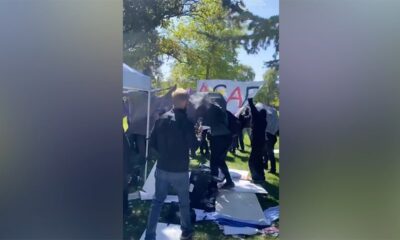Business
On a Hollywood studio lot, a new New York comes to life
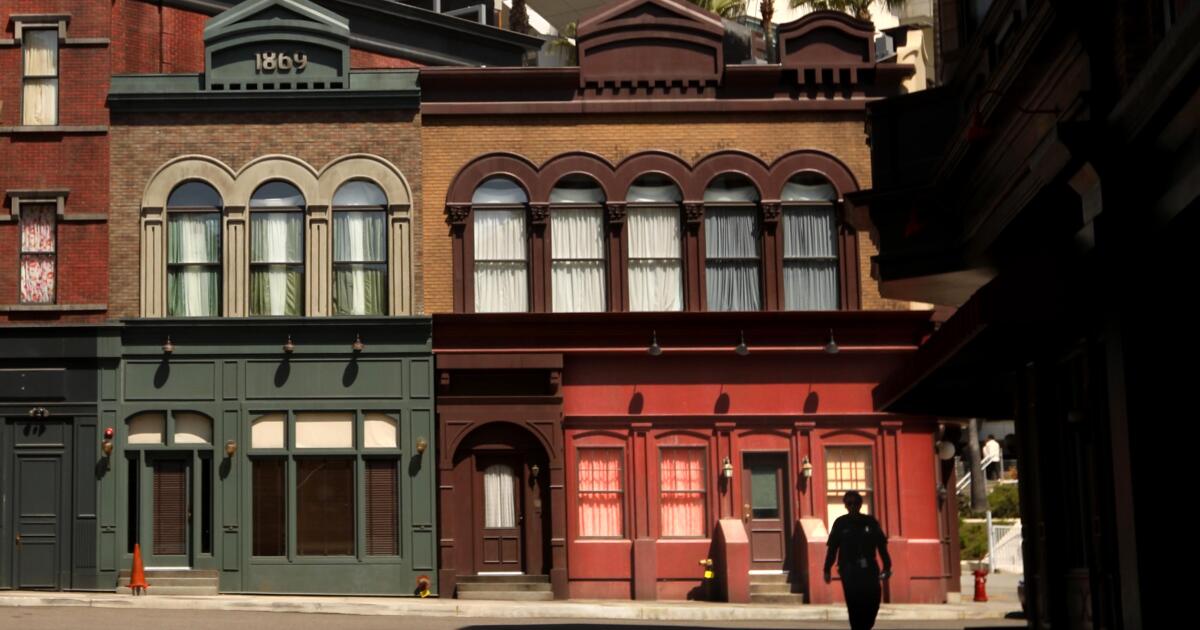
Last summer, when the Hollywood writers’ strike had shut down film and television production, a crew of scenic painters at the legendary Fox Studio Lot took advantage of the lull to mess up New York City.
Work had recently been completed on a new set of façades meant to mimic Manhattan streets, but the result was too pretty and clean. Even the smooth gray concrete curbs looked suspiciously fresh.
“After the curbs were perfectly poured, we had a gentleman with a jackhammer come in here and chip away at them,” said Gary Ehrlich, president of studio operations. “It was slightly heartbreaking to see.”
Today, the curbs are suitably beaten up, with dings and black smears as if tires had been rubbing against them for decades. Fire escapes look corroded and other metal fixtures such as banisters have been coated to look old or rusty, while walls appear water-stained. A patina of age has settled over this faux city.
A film crew gets ready for a shoot at the new New York set at Fox Studios in Los Angeles on March 26, 2024. The new set that is different from conventional backlot façades because it has stages inside the New York “buildings” where filming can take place.
The painstaking besmirchment of New York Street was one more twist in the long saga of one of filmdom’s most famous outdoor sets. Looming near the front gate like an adult-sized playhouse, an earlier version of the set and now the new one have long served notice to visitors that they have arrived at a movie studio that is itself a leading character in Hollywood lore.
Its lineage is suitably rich in Hollywood flavor: In 1967 Fox was preparing to shoot the film version of “Hello, Dolly!,” a Tony-award winning musical set in 1890s New York City that ran for years on Broadway. The script included a spectacular outdoor parade with thousands of extras, and studio executives determined that it would be impossible to shoot on location in New York because the city had changed too much.
Fox production designer John DeCuir, who had already won Academy Awards for his design of “The King and I” and “Cleopatra,” came up with a streetscape that required more than 500 workers to labor for four months to build. The $2.25-million price tag made it the most costly movie set built to date, the UPI news service reported at the time.
It required more than 300,000 feet of board lumber and 22 miles of telephone wire strung between poles, the way it was in old New York. A painted 11-story office building façade obscured the view of the Century Plaza Hotel looming next to the lot, according to Barbra Archives, which chronicles the career of “Hello, Dolly!” star Barbra Streisand.
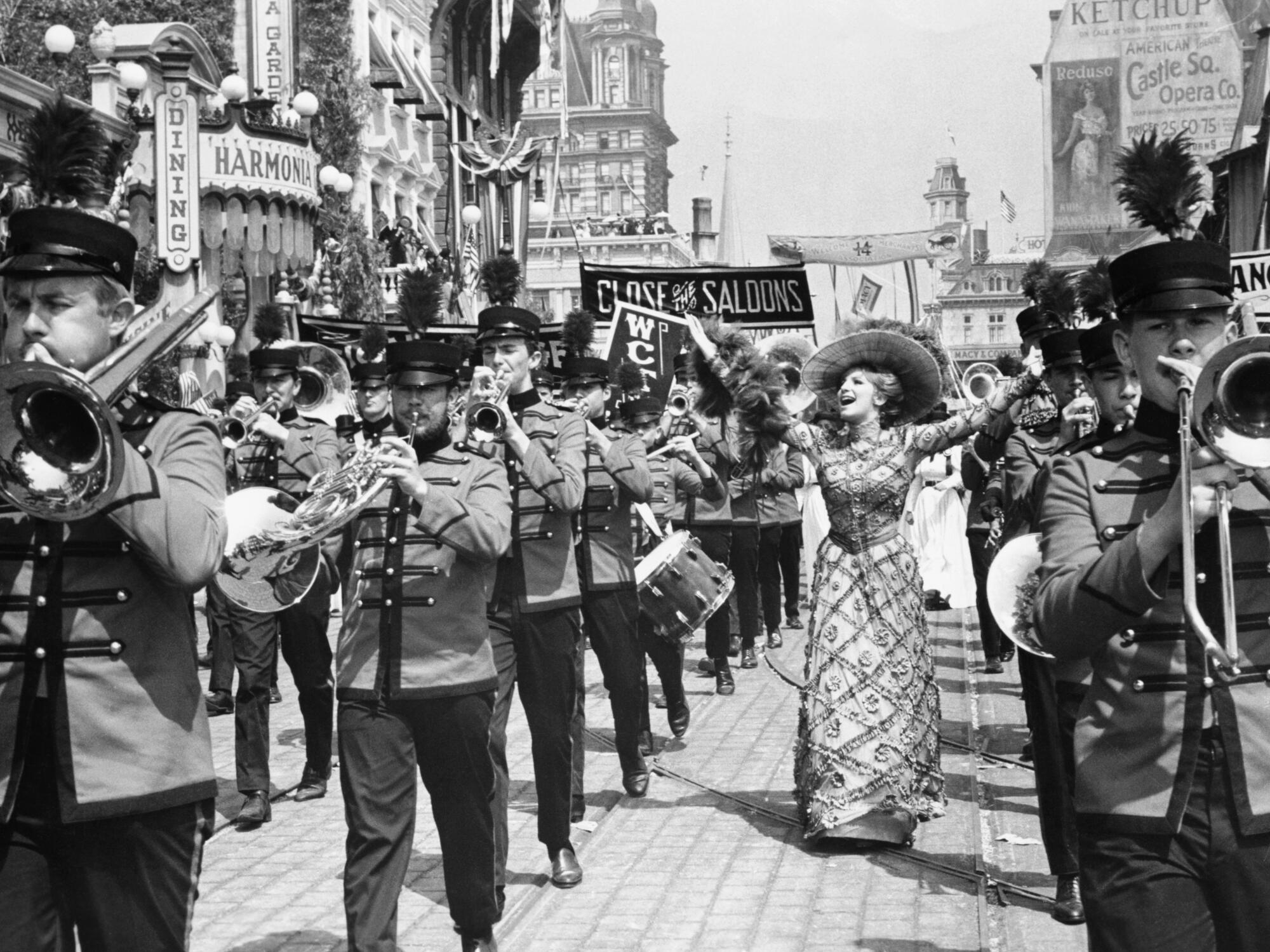
Barbra Streisand marches with a band in a scene from the 1969 romantic comedy “Hello, Dolly!” filmed on Fox’s New York set in Century City.
(John Springer Collection / Getty Images)
Dominating the street was a replica of an elevated train station and a steam locomotive acquired from a sugar plantation in Hawaii, where it had been used to transport workers.
On July 16, 1968, the Valley Times reported, “The parade stretching one-fifth of a mile and comprised of 675 persons in 16 units passed through a crowd of 3,108 film extras” in period costumes. Among the performers were the UCLA marching band and the Budweiser Clydesdales. The director was actor-dancer Gene Kelly.
As impressive as the set was, it was intended to be temporary, said Michael Whetstone, a production designer who worked on building the new version of New York Street.
“It was supposed to be torn down but wasn’t because it was too expensive” to remove, he said. At the time the studio was reeling from financial setbacks including a $30-million loss on “Hello, Dolly!,” according to the New York Times.
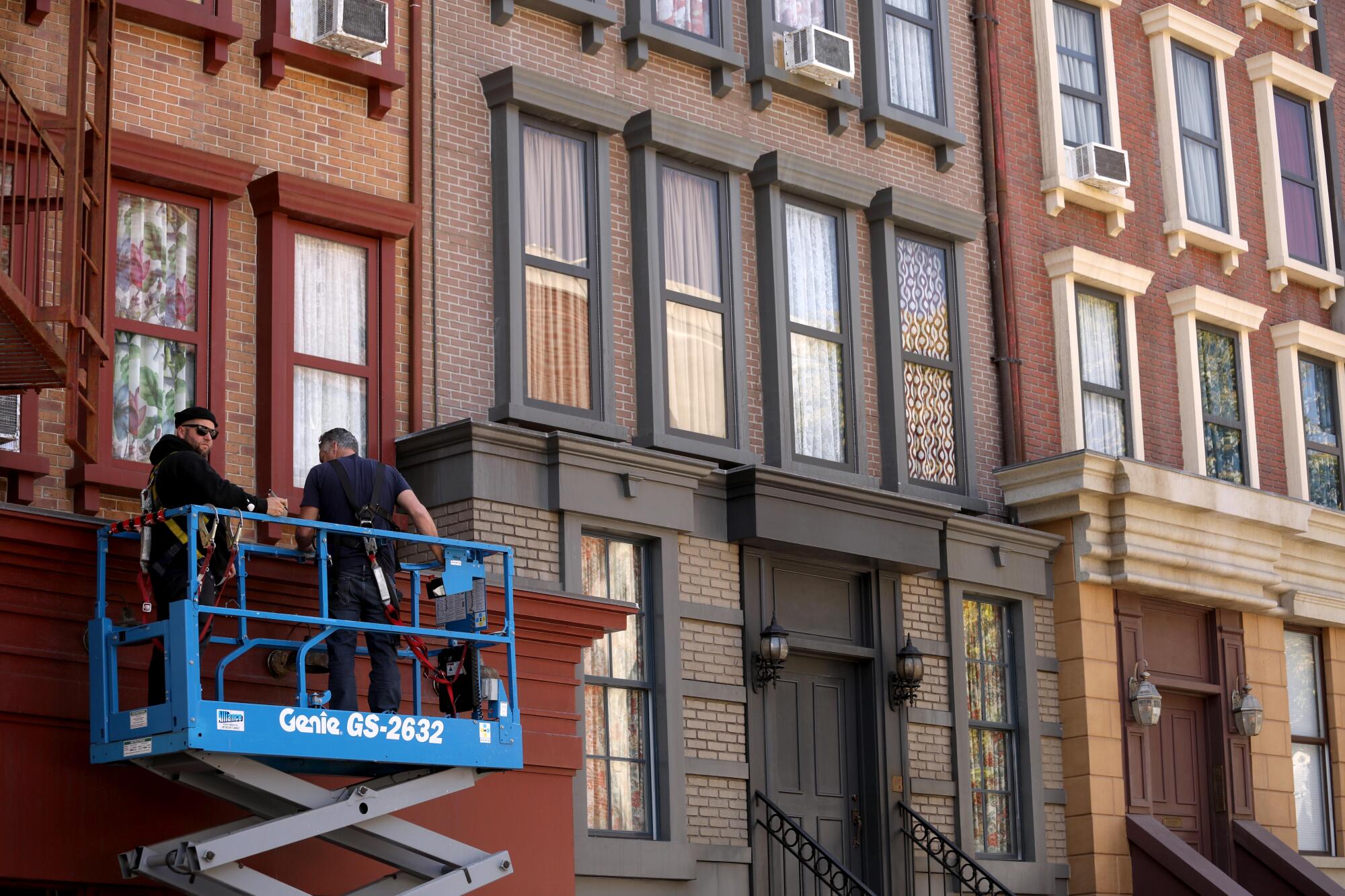
Maintenance and prop makers James Scobie, left, and Norm Greene, work on the façade of the new New York set at Fox Studios .
The set enjoyed a second, money-making act in the years that followed as Fox rented it out for use on pictures that included Warner Bros.’ comedy “Up the Sandbox,” starring Streisand, and MGM’s musical “New York, New York,” starring Liza Minnelli and Robert De Niro. Among the television shows that used it were “Charlie’s Angels” and “Moonlighting,” while Bruno Mars, Lady Gaga and other musicians used it for music videos.
But a few years ago, with the set showing its age, the studio started considering its replacement, Ehrlich said. “It had been exposed to the elements for five decades and was past its useful life.”
Fox tapped Culver City architect Nathan Moore of House & Robertson Architects to design something sturdier.
Construction required 49 tons of rebar and more than 1,000 cubic feet of concrete. The set is held up by 260 tons of structural steel and backed inside with 4,400 square feet of catwalks. Lighting and other electrical functions are supported with 21,000 square feet of conduit and wire, allowing productions to hook up to house power instead of rolling in generators. The set also had to comply with building codes and be tracked by city building inspectors.
The new New York Street was made to look like the city in the mid 20th century, a decision that required detailed craftsmanship such as window heads and sills that would have been carved out of wood in years past but were instead fabricated out of plastic foam and finished with plaster. Windows were installed to be easily replaced so productions can break them when scenes call for it.
Whetstone oversaw the project and, as part of his research, made several trips to New York, spending long hours on foot trying to get a sense of how light plays on buildings at night.
“I was literally walking Lower Manhattan from 10 p.m. to 4 in the morning taking pictures,” he said.
Where the original “Hello, Dolly!” set was based on a commercial section of 1890s New York suitable for a parade, Fox elected to make the new set feel like a neighborhood from a later era.
“It’s more Lower Manhattan, more Bowery,” Whetstone said. “Definitely the Lower East Side.”
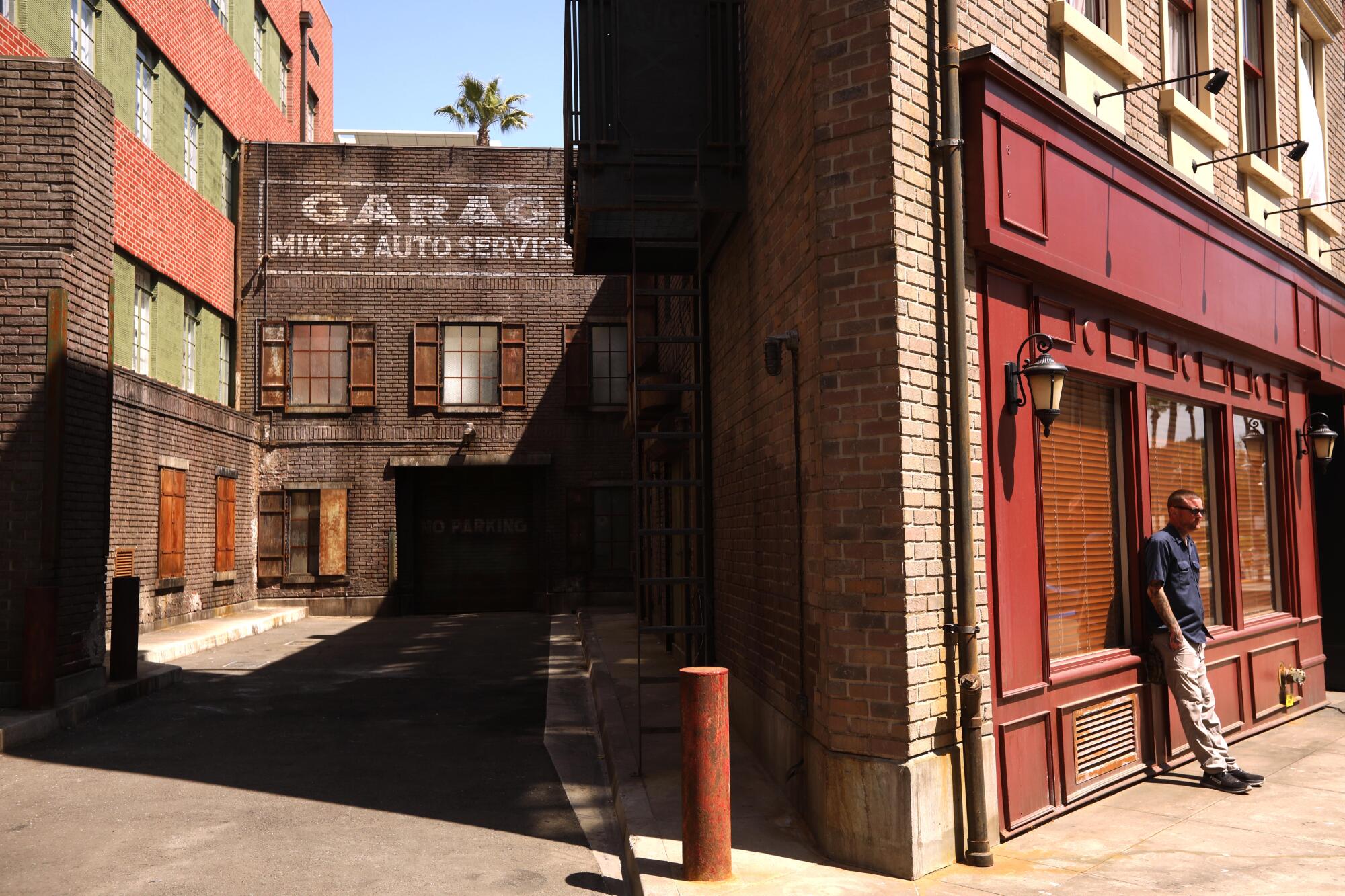
A film crew member waits to set up for a shoot at the new New York set.
While the set is “a default vision of New York City,” said Whetstone, it also is intended to stand in for any major city. Through the years, Fox’s New York Street has subbed for Chicago, Washington, D.C., and Pasadena.
Even though improving camera technology through the years has made it easier to shoot on location, there are reasons filmmakers keep shooting on studio lots, said Jason E. Squire, entertainment podcaster and professor emeritus at USC School of Cinematic Arts.
As filming equipment and cameras got lighter and more portable, the more free-flowing New Wave cinema that emerged in the late 1950s and ’60s employed provocative camerawork.
“This liberation led to people shooting off the studio lot,” Squire said. “Filmmakers wanted to get away from the studio.”
But it has remained expensive to shoot a large-scale production in the real world with all the vehicles, equipment and personnel required to be transported and managed on-site.
“One of the key decisions early in any production is whether to build sets on a lot or shoot in a real location,” Squire said. “That depends on how intricate the sequences are going to be, how intimate. It’s a judgment call and a money call, and the money usually wins.”
Shooting behind studio gates also prevents uncomfortable collisions between fantasy and reality.
“On the lot you don’t have interference from civilians,” Squire said. “You can control traffic, you can control lighting. All of the equipment is at your beck and call.”
Whetstone recalled having to flee location shooting in downtown L.A.’s Arts District when working on Season 1 of “New Girl,” a Fox television comedy starring Zooey Deschanel that premiered in 2011.
“We started out shooting in downtown Los Angeles, and by the end of our fifth night shoot we had angered so many of the neighbors around in the community that we ended up building downtown L.A. on the Fox lot,” Whetstone said.
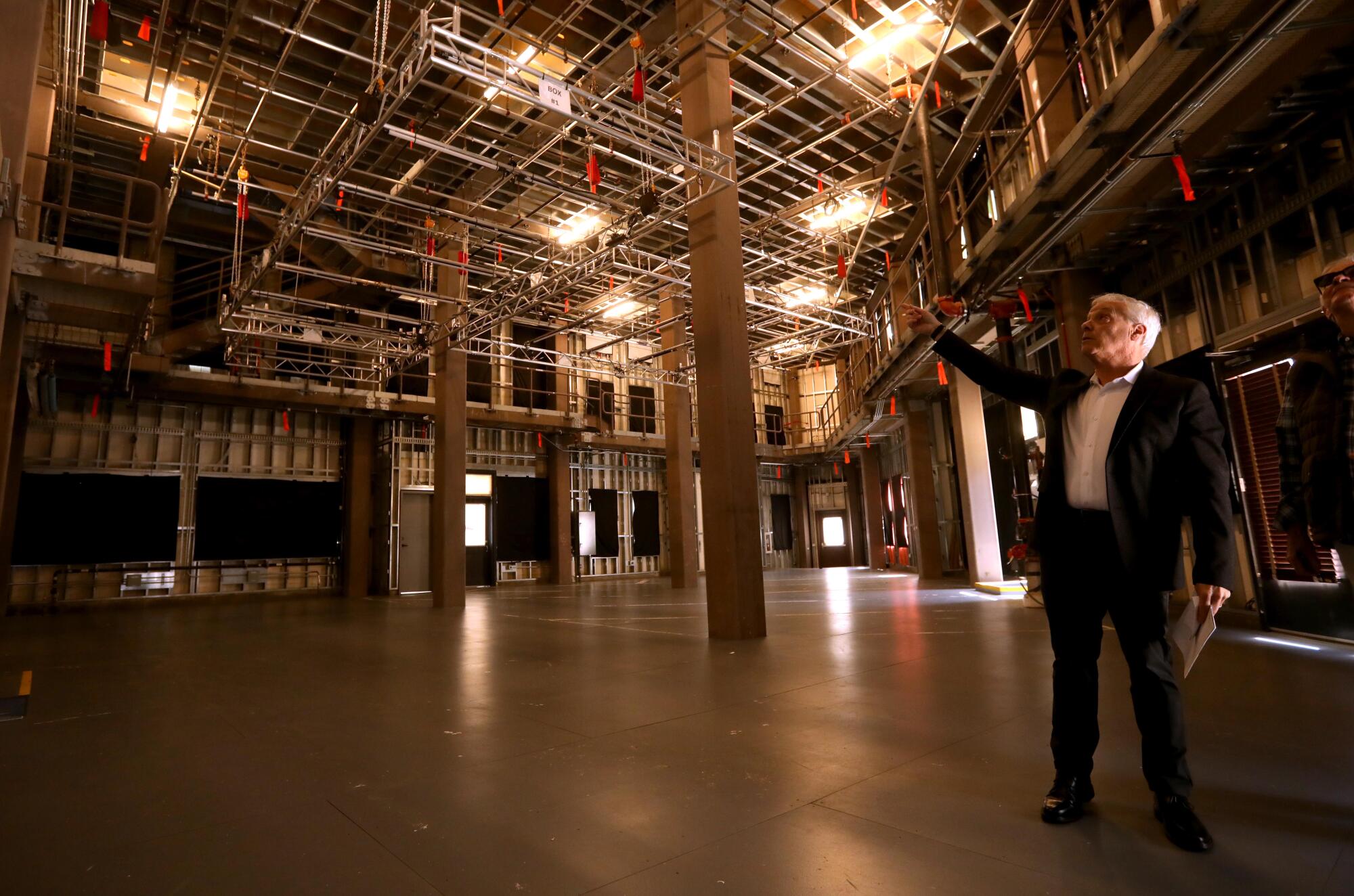
Gary Ehrlich, president and general manager of studio operations at Fox Studio Lot, shows off the scaffolding for lighting inside one of the buildings in Fox’s new New York Street set.
The makeover of New York Street is in addition to a planned $1.5-billion upgrade of the Fox Studio Lot announced last year by Fox Corp. that is to include more soundstages and offices. Fox Corp. retained ownership of the lot when Walt Disney Co. bought most of 21st Century Fox’s entertainment assets in 2019.
The upgrades come as the real New York mounts an aggressive effort to lure TV and movie producers from L.A. by building new studios and soundstages.
On New York Street in Los Angeles, Fox also was able to transform the set behind the façades, adding 4,000 square feet of interior space that makes it easier to meld outdoor and indoor action. The studio declined to reveal exactly how much the new multimillion-dollar set cost, but Fox wants it to stand for another half-century at least.
“This project was approached not just as temp architecture but as something more permanent,” Whetstone said. “We want this to last a long time.”

Business
Autoworkers Union Chief Gives Trump’s Tariffs a Mixed Review

The head of the United Automobile Workers union voiced partial support on Thursday for the Trump administration’s tariffs, saying targeted duties on other countries could help bring some manufacturing jobs back to the United States.
But the union’s president, Shawn Fain, described President Trump’s across-the-board global tariffs as “reckless.” In an address to U.A.W. members that was streamed on YouTube and other social media, he also strongly criticized the administration for firing federal workers and slashing key government agencies, and accused it of violating the civil rights of students and others.
“We support use of some tariffs on automotive manufacturing and similar industries. We do not support tariffs for political games about immigration or fentanyl,” Mr. Fain said. “We do not support reckless tariffs on all countries at crazy rates.”
The address appeared aimed at distancing the union leader from Mr. Trump. In previous weeks, Mr. Fain praised the White House’s tariff plans and faced some criticism for moving closer to an administration that often shows hostility to organized labor. He campaigned frequently and enthusiastically last year for former Vice President Kamala Harris, the Democratic presidential nominee, often rousing crowds by referring to Mr. Trump as a “scab.”
“We are not aligning everything we do with the Trump administration,” Mr. Fain said on Thursday. “We are negotiating with the Trump administration.”
Mr. Fain used the address to repeat familiar claims that free trade agreements — in particular, the North American Free Trade Agreement — allowed corporations to move U.S. factories and jobs to low-wage countries. He said some 90,000 factories in the United States closed in the last 30 years, hollowing out once thriving manufacturing cities like Flint, Mich., and Gary, Ind.
While he blamed both Democrats and Republicans for supporting policies that have hurt U.S. manufacturing, Mr. Fain said the resulting “pain and anger” had led many workers who traditionally supported Democrats to gravitate toward Mr. Trump.
“We have to end this free trade disaster, and we don’t care whether it’s a Republican or Democrat who does it,” he said.
Mr. Fain said that General Motors, Ford Motor and Stellantis had excess manufacturing capacity in their U.S. plants and could create thousands of auto assembly jobs by making full use of them.
He added that he disagreed with “90 percent of what the Trump administration is doing,” especially the cuts at the National Institutes of Health that have disrupted research into cancer and other diseases.
“We’ve seen the destruction of bargaining rights for one million federal workers. We’ve seen an attack on the National Labor Relations Board and the illegal firing of a board member,” he said. “We’ve seen the attacks on Social Security and Medicare and Medicaid, programs that millions in the working class depending on.”
Mr. Fain did not mention Elon Musk, who as an adviser to Mr. Trump has been leading efforts to fire tens of thousands of federal workers and to make deep cuts at agencies including the Department of Education and Department of Veterans Affairs. Mr. Musk, the chief executive of Tesla, has strongly opposed U.A.W. efforts to organize Tesla’s workers in the United States.
Mr. Fain noted that Mahmoud Khalil, the recent Columbia University graduate who was arrested by federal immigration agents last month, had once been a student instructor represented by the U.A.W. Grant Miner, a graduate student who was expelled by the university last month, is president of U.A.W. Local 2710, which represents Columbia student workers.
Business
DoorDash rolls out food delivery robots in Los Angeles

A robot on wheels could serve up your next meal thanks to a partnership between DoorDash and Coco Robotics that’s bringing food delivery robots to Los Angeles sidewalks.
The food delivery service DoorDash announced Thursday that eligible customers in Los Angeles and Chicago can order food through their app to be delivered by a small, box-shaped robot with zero emissions.
Coco Robotics and similar companies such as Serve Robotics and Starship Technologies have been operating food delivery robots in Los Angeles and other cities for several years. DoorDash’s international arm Wolt began a partnership with Coco in Helsinki, Finland this year.
“We’re excited to expand our partnership with DoorDash, combining Coco’s AI robocourier platform with DoorDash’s national scale and reach,” Coco Chief Executive Zach Rash said in a statement. “This collaboration marks an important step forward in reshaping urban delivery in the U.S.”
Coco has a fleet of more than 1,000 delivery robots that are remotely controlled by human operators. The company is headquartered in Santa Monica and was founded in 2020 by two UCLA graduates.
Despite the challenges of navigating busy city sidewalks and crosswalks already shared by pedestrians, Coco robots have completed more than 400,000 deliveries and partnered with hundreds of restaurants. Using delivery robots instead of human drivers can save restaurants up to 50% in profits, according to Coco’s website.
Frustrated or skeptical passersby have kicked the bots or intentionally obstructed their path, while the cities of New York and San Francisco have banned them, on and off, because of congestion concerns. Some opponents say the bots take jobs from human workers and contribute to chaotic urban traffic.
DoorDash Labs, the company’s robotics and automation arm involved in the Coco partnership, announced a collaboration last year with a drone delivery service called Wing. Wing drones began delivering food in Christiansburg, Va., in March 2024 after launching a pilot program in Australia in 2022.
“Not every delivery needs a two-ton car just to deliver two chicken sandwiches,” Harrison Shih, senior director of DoorDash Labs, said in a statement. “We believe the future of delivery will be multi-modal, and we’re thrilled to partner with Coco to expand sidewalk robot deliveries that complement the Dasher network.”
Coco robots will partner with nearly 600 merchants in Los Angeles through the DoorDash app. The robots’ median delivery distance is one mile, according to a company spokesperson.
Business
After Trump’s Tariffs Pause, the EU Takes a Moment to Reassess

European Union officials had just approved retaliatory levies of 10 to 25 percent on about $23 billion of American imports when President Trump abruptly changed tack on Wednesday, announcing that he would hit pause on some of the tariffs he had placed on Europe and much of the rest of the world.
Mr. Trump’s announcement signaled what European leaders had been hoping for: a willingness to negotiate. Financial markets surged on the news, greeting it as evidence that an all-out trade war might be averted.
But European leaders on Thursday morning were taking time to assess exactly what the announcement meant and how they should respond.
The Trump administration is pausing what it has called “reciprocal” tariffs — across-the board taxes that apply in different amounts to different countries — that Mr. Trump announced on April 2. At that time, he said the European Union would face a 20 percent tariff. With his about-face on Wednesday, it is likely that the bloc would instead face a 10 percent across-the-board tariff for the next 90 days, during the pause.
But the 25 percent tariffs that Mr. Trump has placed on both cars and on steel and aluminum seemed to be still in place — and Europe’s retaliation, approved on Wednesday, was in response to those metal-sector tariffs, not to the tariffs that Mr. Trump has now delayed. European Union officials have yet to announce whether that retaliation would go ahead.
Officials “will now take the necessary time to assess this latest development, in close consultation with our member states and industry, before deciding on next steps,” Olof Gill, a spokesman for the European Commission, the bloc’s executive arm, told reporters in a written statement on Thursday.
Still, White House officials voiced optimism that Europe’s retaliatory levies, which were meant to phase in starting April 15, would now be delayed.
“I think what’s going to happen is they are going to be pushed out for the 90 days, so they have time to negotiate with the president without having something hanging over their head,” Howard Lutnick, the U.S. commerce secretary, told reporters at the White House on Wednesday.
Donald Tusk, prime minister of Poland, wrote on social media, “Let’s make the best of the next 90 days.”
Ursula von der Leyen, president of the European Commission, said in a statement on Thursday that she welcomed Mr. Trump’s delay and wanted to negotiate.
She called the announcement “an important step towards stabilizing the global economy.”
Ms. von der Leyen has in recent days suggested repeatedly that both Europe and the U.S. should drop tariffs on industrial products, including cars, to zero.
“Tariffs are taxes that only hurt businesses and consumers,” she said. “That’s why I’ve consistently advocated for a zero-for-zero tariff agreement between the European Union and the United States.”
But she also underscored that Europe would continue its strategies of striking new trade alliances, deepening internal trade between nations and working on improving its own competitiveness, measures meant to make it less reliant on an increasingly fickle United States.
“This crisis has made one thing clear,” she wrote. “In times of uncertainty, the single market is our anchor of stability and resilience.”
-

 Technology1 week ago
Technology1 week agoThe FAA hiding private jet details might not stop celebrity jet trackers
-

 News1 week ago
News1 week agoSupreme Court Rules Against Makers of Flavored Vapes Popular With Teens
-

 News1 week ago
News1 week agoNYC Mayor Eric Adams' corruption case is dismissed
-

 Technology1 week ago
Technology1 week agoHere’s how you can preorder the Nintendo Switch 2 (or try to)
-

 News1 week ago
News1 week agoTrump’s ‘Liberation Day’ Tariffs Are Coming, but at a Cost to U.S. Alliances
-

 News1 week ago
News1 week agoTrump to Pick Ohio Solicitor General, T. Elliot Gaiser, for Justice Dept. Legal Post
-

 Politics1 week ago
Politics1 week agoFBI flooded with record number of new agent applications in Kash Patel's first month leading bureau
-

 Business1 week ago
Business1 week agoMarkets Remain Uneasy as Trump Prepares Sweeping ‘Reciprocal’ Tariffs





